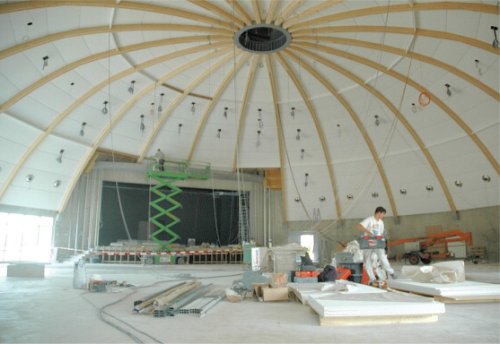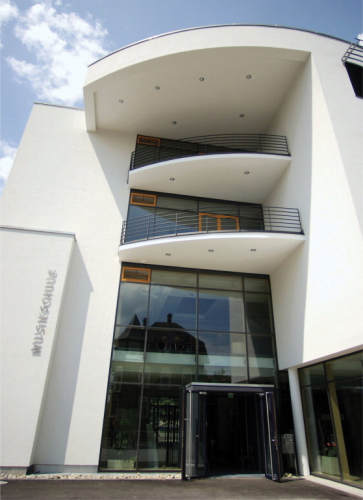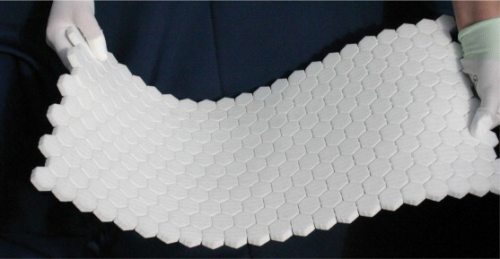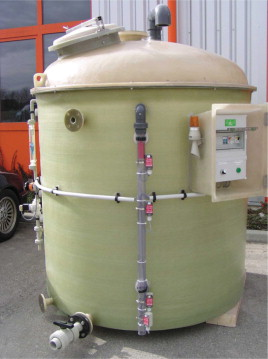



One of the oldest applications for composite structures is the building industry. Glass reinforced plastic (GRP) components have been used in this sector for over three decades. As a building material, composites are suitable for numerous applications – pipes, sills, slabs, formwork, linings, pillars, foundations, tanks, housings, containers, doors, covers, bricks, walls, frames, steps, gutters – and the possibilities are virtually unlimited. Composites innovations continue to find their way onto building sites. For example, Mühlmeier Composite, based in Bärnau, Germany, together with a partner company, has developed scaffolding boards made from GRP. “The idea was to replace the heavy timber boards and thus to relieve the stress on high scaffolding as well as to enable a higher transport and erection performance by scaffolders,” explains managing director René Mühlmeier. “At the same time, an equivalent or even better a higher TBO was to be achieved than with aluminium.” The objective was achieved. A saving in weight in excess of 20% was achieved over conventional timber scaffolding boards and, after successful load and weathering tests, the supervising authority granted general approval. “Computations were initially made of various laminate designs,” Mühlmeier explains. “With a special glass fibre interlaid scrim, several layers of conventional laminate were replaced without any loss in strength. We also benefited from the experience gained from wind turbines, whose rotors are also manufactured from multiaxial interlaid scrim from our company. The boards are manufactured in presses, under high pressure and temperature. The semi-finished products are made up so that further processing takes very little time.”
Mühlmeier currently supplies over 70 customers in the construction industry with around 1300 tonnes of glass fibre products and resins annually. Apart from façade panels, tank systems and liners for sewer refurbishment, the most important end products are sanitaryware as well as ready-to-install sanitary modules. For over 30 years, these have been made from GRP, and the company was working in this sector from the very beginning. In addition, there are a multitude of semi-finished and niche products. Around 35% of sales are achieved with direct or indirect construction applications. Mühlmeier will be one of the exhibitors at Composites Europe 2007 on 6-8 November in Stuttgart, Germany.
“Resistance to chemicals (and where necessary with a fire protecting finish), easy processing and uniformity are the features that make composite materials of interest to the construction industry,” states Mühlmeier. “Glass fibre mats, fabrics and interlaid scrim as well as sprayed and wrapped rovings with appropriate resin systems are the products that are primarily used. They are optimised for the known processing methods, as well as being adapted or made up in line with the requirements of the application.” Mühlmeier views the future optimistically. “Only in recent years has modern architecture discovered the potential and the possibilities of fibre reinforced plastics,” he says. “New materials such as our 3D-Core are currently being reviewed for interesting and highly promising projects.” Thermoplastic honeycomb core materials of polypropylene (PP) are manufactured by Tubus Waben GmbH & Co KG from Rottenbach, Germany. These are used in the manufacture of panels, shaped parts and other sandwich structures. “Tubus Honeycomb PP forms the core layer on which various materials are applied as cover layers on both sides, by means of various technical processes,” according to the managing director Andrea Kropp. A modified PP honeycomb has been developed that fulfils the requirements of DIN 4102, Part 1 Building materials, Class B1. According to Kropp, “this is a precondition for the use of our thermoplastic sandwich cores in the building industry.” Panels are the biggest application for PP honeycombs, but applications are numerous and extend from internal finishing via façade elements to scaffolding, stage, trade fair and shop fittings and even clean room technology. Due to high pressure, stability as well as impact resistance, media stability, low water intake and noise absorption, Tubus Waben's materials are very suitable for the building industry. The honeycomb core is prepared for the end application through the adhesion of suitable finishing coatings – wood, plastic, prepregs, metals or minerals. Cold, hot and vacuum pressing are the techniques used for this in conjunction with suitable adhesion systems. In the years to come, Kropp expects growth for Tubus Waben in the lightweight construction sector. A light filler of expanded glass granulate is supplied by Dennert Poraver GmbH, from Schlüsselfeld. ‘Poraver’ is made from recycled glass using a patented process.
“Poraver is used worldwide as an additive for innumerable products in the building and construction industry,” according to marketing manager Philip Brdlik. “It can also be used as an additive in solid wall systems, plasters, mortar, tile adhesives, embossed wallpapers, façade sections, grinding wheels, ultra-light ship floor paving or model building products.”
Dennert Poraver manufactures around 1 million m3 of the product annually. “Poraver is light, stable, chemically resistant, free from pollutants and is suitable for thermal and acoustic insulation,” says Brdlik. “Consequently, it is used in the building industry in various composite materials, such as reaction resin mortar, polymer concrete, kitchen work surfaces and mineral foams.” “By means of the non-combustible Poraver, epoxy, polyurethane, acrylic and polyester resins are also improved in terms of behaviour in fire and processing characteristics,” he says. Nordmann, Rassmann GmbH (NRC) from Hamburg is a long serving materials supplier to the construction industry. “We offer an extensive range of dispersions, resins, fillers, pigments, thickeners, fluidisers for liquid, pasty and powdery construction products”, states Axel Förster, general manager for Construction, Coating and Process Chemistry at the company. Based on the number of employees and sales, the construction, paints and lacquers segment is one of the most important trading divisions of NRC. Vinyl ester resins, which are characterised by outstanding chemical and thermal resistance, are one of its most important materials. These are used primarily for the manufacture of tanks in plant construction, pipe systems and ducts. Respecta Maschinenbau GmbH from Wülfrath, Germany, supplies process machinery and plant. Sales manager Dieter Dohnau states that the company has been supplying equipment to the building industry for 38 years and has several hundred companies on its customer list. Respecta offers plant for two processing technologies: solid surface and engineered stone.
“High-grade, non-porous surface materials can be created for a large range of applications and with a variety of designs and shapes,” according to Dohnau. “Slabs are produced by pouring, and are made into the final product by further machining, such as cutting, grinding and polishing.”
COMPOSITES EUROPE 2007 will be held on 6-8 November in Stuttgart, Germany, one of the world's most dynamic economic regions. In choosing this location the organisers Reed Exhibitions Deutschland GmbH, EuCIA and Reinforced Plastics continue their strategy of holding COMPOSITES EUROPE in the most important centres of composites application in Europe. After the successful first COMPOSITES EUROPE, a total of more than 200 exhibitors and 4000 international visitors are expected. Over 120 international companies, institutions and organisations have already booked a stand at COMPOSITES EUROPE 2007, including EADS, AOC, Huntsman, Menzolit, Exel Oyj, Röchling, and Büfa. |
The end products include high-grade kitchen and laboratory work surfaces, kitchen sinks, table tops, wall panels and elements, washbasins, bathroom furniture, bathtubs, shower trays or floor coverings. Solid surface includes materials that are formulated from so-called ‘soft’ fillers and polyester resin or acrylic. Engineered stone consists primarily of hard minerals such as quartz, granite or marble bonded with epoxy, polyester resin or acrylic. Respecta also produces systems for manufacture of polymer concrete, a highly filled plastic. The filler ratio is generally in excess of 90% by weight. A large variety of fillers can be processed, from quartz flour to secondary raw materials such as broken glass or rubber granulate, mixed with various binders such as epoxy, unsaturated polyester or polurethane resins. Strength, surface finish, chemical and frost resistance make the material an economic alternative to standard cement concrete, Dohnau states. Possible applications in industry and for the leisure sector are extensive and good prospects are seen for this material in the building industry.






